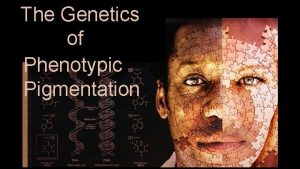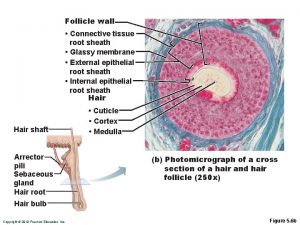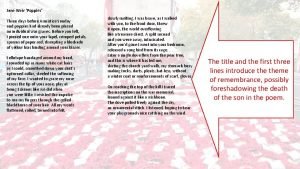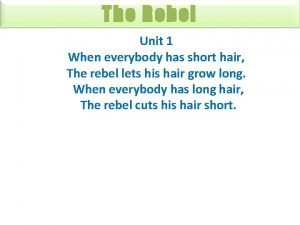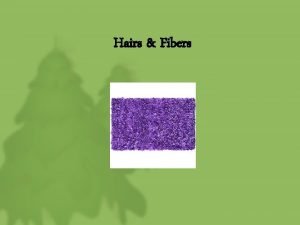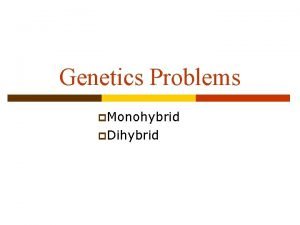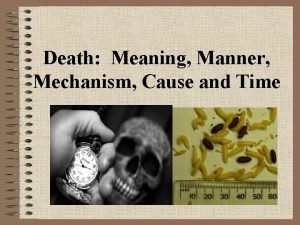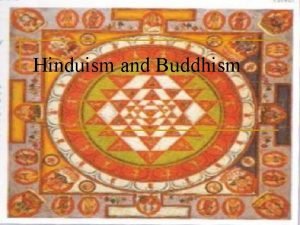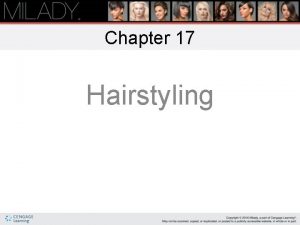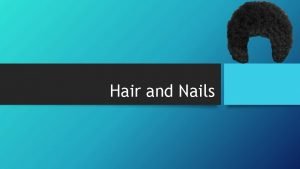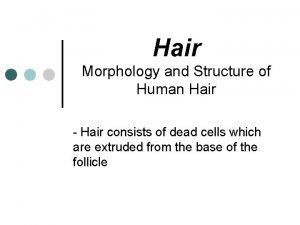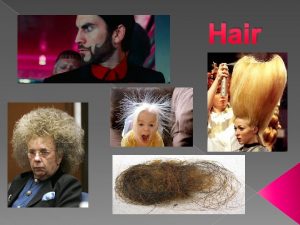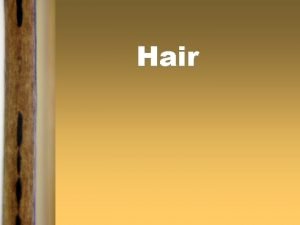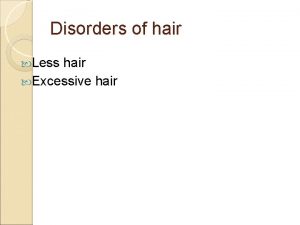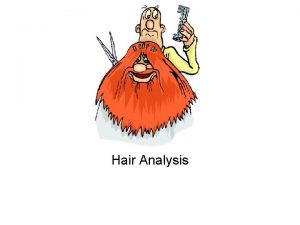For three days after death hair and fingernails














































- Slides: 46

“For three days after death, hair and fingernails continue to grow but phone calls taper off. ” —Johnny Carson Comedian and television host

Hair Analysis § Mainly composed of dead protein § Hair is class evidence § Hair can be used to back up circumstantial evidence § Hair absorbs and adsorbs substances both from within the body and from the external environment 2

Introduction § Human hair is one of the most frequently found pieces of evidence at the scene of a violent crime. § It can provide a link between the criminal and the crime. § From hair one can determine: § If the source is human or animal § Race (sometimes) § Origin of the location on the source’s body § Whether the hair was forcibly removed § If the hair has been treated with chemicals § If drugs have been ingested Kendall/Hunt Publishing Company

Hair Shaft Composed of: § Cuticle—outside covering, made of overlapping scales § Cortex—inner layer made of keratin and imbedded with pigment; also contains air sacs called cortical fusi § Medulla—inside layer running down the center of the cortex Kendall/Hunt Publishing Company 4

The Cuticle • The cuticle is the outermost layer of hair which is covered with scales. • The scales point toward the tip of the hair. • Scales differ between species of animals and are named based on their appearance. • The three basic patterns are: § Coronal § Spinous § Imbricate

Coronal Scales Spinous Scales Bat Hair Imbricate Scales Mink Hair Human Hair

The Cortex The cortex gives the hair its shape. It has two major characteristics: § Melanin—pigment granules that give hair its color § Cortical fusi—air spaces, usually found near the root but may be found throughout the hair shaft

The Medulla The medulla is the hair core that is not always visible. The medulla comes in different types and patterns. Types: § Intermittent or interrupted § § Fragmented Continuous Stacked Absent—not present Kendall/Hunt Publishing Company 8

Continuous Absent Types of Medulla Fragmented Interrupted

Note the difference in medulla, this is the best way to tell human from non-human hair 10

Medullary Index Determined by measuring the diameter of the medulla and dividing it by the diameter of the hair. § human hair is generally less than 1/3 § animal hair is usually greater than ½ 11

Hair Growth §Terminology § Anagen—hair that is actively growing; lasting up to 5 years § Catagen—hair is not growing; a resting phase § Telogen—hair that is dying and ready to fall out; lasting two to six months §Grows about 0. 5 mm per day or 1 centimeter per month; (one half inch per month) Kendall/Hunt Publishing Company 12

The Root Human roots look different based on whether they have been ripped out or if they have fallen out. Animal roots will vary, but in general have a spear shape. Ripped Out Fallen out Kendall/Hunt Publishing Company 13

Hair Comparison § Color § Length § Diameter § Distribution, shape & color of pigment § Dyed hair has color in cuticle and cortex § Bleaching removes pigment and gives a yellow tint § Scale types § Presence or absence of medulla § Medullary type § Medullary pattern § Medullary index Kendall/Hunt Publishing Company 14

DNA from Hair § The root contains nuclear DNA. § If the hair has been forcibly removed, some folicular tissue may be attached containing DNA. § The hair shaft contains mitochondrial DNA § inherited only from the mother. § can be typed by comparing relatives if no DNA from the body is available. § more difficult and costly than using nuclear DNA. Kendall/Hunt Publishing Company 15

Collection of Hair § Questioned hairs must be accompanied by an adequate number of control samples. § from victim § from possible suspects § from others who may have deposited hair at the scene § Control Sample § 50 full-length hairs from all areas of scalp § 24 full-length pubic hairs Kendall/Hunt Publishing Company 16

Hair Toxicology § Advantages: § Easy to collect and store § Is externally available § Collections must be taken from different locations on the body to get an accurate timeline. § Since hair grows about 1 cm per month, history of drug use or poisoning can be tracked § Example: Poison found 2 cm from root = They were poisoned 2 months ago Kendall/Hunt Publishing Company 17

Human & Animal Hair Differences Human Hair Medullary Index (thickness) greater than 1/3 Animal Hair Medullary Index (thickness) less than ½ Medulla is not continuous Medulla is continuous Scales(cuticle) are imbricate Scales(cuticle) are spinous or coronal ***Note: The best way to tell the difference between human and animal hair is by examining the medulla

Which of the below are animal hairs? A B C D G E F H Think About It … (1) In which samples are we viewing the cuticle? How do they compare? (2) In which samples are we viewing the medulla? How do they compare? (3) What characteristics can be used to identify hair samples? I

Animal Hairs - Key A Cat B Horse C Pig D Human G E Deer F Dog Rabbit H Rat I Human

Fiber Analysis

Fibers • Considered class evidence • Have probative value • Are common trace evidence at a crime scene • Characterized based on comparison of both physical and chemical properties

Fabric is made of fibers. Fibers are made of twisted filaments. Types of fibers and fabric: 1. Natural—animal, vegetable, or inorganic 2. Artificial—synthesized or created from altered natural sources

Types of Fibers Synthetic Natural Rayon Silk Nylon Cotton Acetate Wool Acrylic Mohair Spandex Cashmere Polyester Linen

Natural Fiber Classification Natural fibers are classified according to their origin: Vegetable or cellulose Cotton—vegetable fiber; strong, tough, flexible, moisture-absorbent, not shaperetentive Rayon—chemically altered cellulose; soft, lustrous, versatile Animal or protein Wool—animal fiber coming most often from sheep, but may be goat (mohair), rabbit (angora), camel, alpaca, llama, or vicuña light and Silk—insect fiber that is spun by a silkworm to make its cocoon; the fiber reflects has insulating properties Mineral Asbestos—a natural fiber that has been used in fire-resistant substances Fiberglass—a manufactured inorganic fiber

Synthetic Fibers Made from derivatives of petroleum, coal, and natural gas Nylon—most durable of man-made fibers; extremely lightweight Polyester—most widely used man-made fiber Acrylic—provides warmth from a lightweight, soft, and resilient fiber Spandex—extreme elastic properties

Testing for Identification Thermal decomposition—gently heating to break down the fiber Chemical tests—solubility and decomposition Burning: observation of how a fiber burns, the odor, color of flame, color of smoke, and the appearance of the residue

Fiber Flame Tests

Testing for Identification: Burn Test Results Natural Synthetic

Natural vs Synthetic Fibers Synthetic fibers are uniform and more “perfect”

Can you identify the types of fibers shown? A B D Think About It … (1) Which samples are natural fibers? (2) Which samples are synthetic fibers? (3) How could you tell? C E F

Types of Fibers - Key A Acrylic Yarn Polyester Yarn B D Cotton Yarn Rayon Rope Think About It … (1) Which samples are natural fibers? BEF (2) Which samples are synthetic fibers? ACD (3) How could you tell? Uniformity C E Nylon Rope Wool Yarn F

Fiber Evidence Case Study Fiber evidence in court cases can be used to connect the suspect to the victim or to the crime scene. In the case of Wayne Williams, fibers weighed heavily on the outcome of the case. Williams was convicted in 1982 based on carpet fibers that were found in his home, in his car, and on several murder victims.

Fingerprints

First time Fingerprints were used to solve a case https: //www. smithsonianchannel. com/videos/finding-patterns-infingerprints/17000

Latent Prints • Latent fingerprints are NOT VISIBLE to the naked eye. • Consist of the natural secretions of human skin • Oil/Grease • Require development for them to become visible. • Can last for years if not disturbed

Fundamental Characteristics of Fingerprints • A fingerprint is an individual characteristic. • A fingerprint remains unchanged during an individual’s lifetime. • Fingerprints have general characteristic ridge patterns that permit them to be systematically classified. • Fingerprints are formed in first trimester • Created from a series of lines (ridges) and grooves. • Ridge patterns are called MINUTIAE

Loop • Must have one or more ridges ENTERING and EXITING from the SAME side • Most common pattern Whorl • Has at least one ridge that MAKES A COMPLETE CIRCLE Arch • Friction ridges ENTER on one side of the finger and EXIT on the other side. • Rise upward in the middle.

Types of Loops/Whorls/Arches Whorls: Central pocket/double loop/accidental/ • Loops: Ulnar/Radial/Plain • WHAT ELSE? -need to look at test

Ridge Characteristics • Can be found on: • Fingerprints • Footprints • Palm Prints • Minutiae—characteristics of ridge patterns

Fingerprint Minutiae


Minutiae Practice Answers

Comparison • There are no legal requirements in the United States on the number of points required for a match. • Generally, criminal courts will accept 8 to 12 points of similarity.

Developing Latent Prints Developing a print requires substances that interact with oils, causing the print to stand out against its background. • Powders—adhere to both water and fatty deposits. Choose a color to contrast with the background. (Most surfaces—glass/walls etc. ) • Iodine—fumes react with oils and fats to produce a temporary yellow-brown color.

Developing Latent Prints, continued Ninhydrin—reacts with amino acids to produce a purple color. -Good for paper Silver nitrate—reacts with chloride to form silver chloride, a material that turns gray when exposed to light. Cyanoacrylate—“superglue” fumes react with water and other fingerprint constituents to form a hard, whitish deposit.
 Interrupted medulla
Interrupted medulla Things fall apart symbols
Things fall apart symbols Human hair roots demonstrate a wineglass morphology.
Human hair roots demonstrate a wineglass morphology. After me after me after me
After me after me after me John 14 1-3
John 14 1-3 Somatic and molecular death
Somatic and molecular death Fifty days after easter
Fifty days after easter Day of pentecost 50 days after
Day of pentecost 50 days after Is back after days its tied
Is back after days its tied Is back after days its tied
Is back after days its tied Sightd
Sightd Dark hair and blonde hair parents
Dark hair and blonde hair parents What is tacheometric survey
What is tacheometric survey Label the structures of the hair bulb
Label the structures of the hair bulb Ringed hair
Ringed hair Three days to see by helen keller
Three days to see by helen keller On three days ali throws darts at a target
On three days ali throws darts at a target I traced the inscriptions on the war memorial
I traced the inscriptions on the war memorial Three days before armistice sunday
Three days before armistice sunday Critical thinking cda
Critical thinking cda What does a rebel do when nobody talks during the class
What does a rebel do when nobody talks during the class Hair grows in diagonal tubes called hair
Hair grows in diagonal tubes called hair Difference between animal and human hair
Difference between animal and human hair Heterozygous tabby x stripeless
Heterozygous tabby x stripeless Stages after death
Stages after death Hopalong cassidy the great gatsby
Hopalong cassidy the great gatsby Stages after death
Stages after death Heat stiffening and cold stiffening
Heat stiffening and cold stiffening After death images
After death images What do muslims believe about life after death
What do muslims believe about life after death Meaning:manner
Meaning:manner Questioning faith after death
Questioning faith after death Changes after death
Changes after death Dharmannn
Dharmannn Featal distress
Featal distress The primary purpose of shampooing in the salon is to
The primary purpose of shampooing in the salon is to No stem pin curls
No stem pin curls Iso 22301 utbildning
Iso 22301 utbildning Typiska drag för en novell
Typiska drag för en novell Nationell inriktning för artificiell intelligens
Nationell inriktning för artificiell intelligens Ekologiskt fotavtryck
Ekologiskt fotavtryck Varför kallas perioden 1918-1939 för mellankrigstiden?
Varför kallas perioden 1918-1939 för mellankrigstiden? En lathund för arbete med kontinuitetshantering
En lathund för arbete med kontinuitetshantering Personalliggare bygg undantag
Personalliggare bygg undantag Personlig tidbok fylla i
Personlig tidbok fylla i A gastrica
A gastrica Förklara densitet för barn
Förklara densitet för barn











